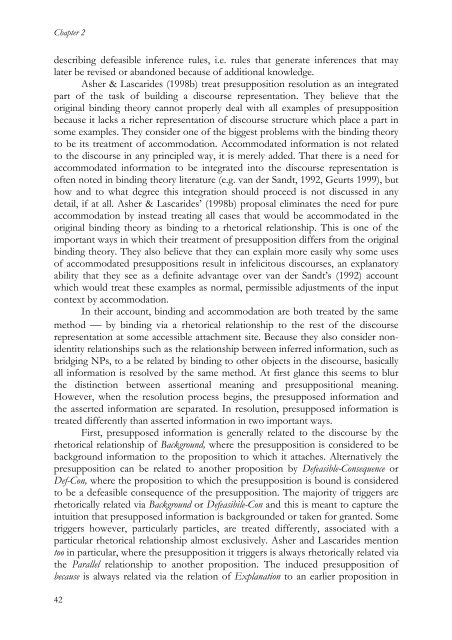Presuppositions in Spoken Discourse
Presuppositions in Spoken Discourse
Presuppositions in Spoken Discourse
You also want an ePaper? Increase the reach of your titles
YUMPU automatically turns print PDFs into web optimized ePapers that Google loves.
Chapter 2<br />
describ<strong>in</strong>g defeasible <strong>in</strong>ference rules, i.e. rules that generate <strong>in</strong>ferences that may<br />
later be revised or abandoned because of additional knowledge.<br />
Asher & Lascarides (1998b) treat presupposition resolution as an <strong>in</strong>tegrated<br />
part of the task of build<strong>in</strong>g a discourse representation. They believe that the<br />
orig<strong>in</strong>al b<strong>in</strong>d<strong>in</strong>g theory cannot properly deal with all examples of presupposition<br />
because it lacks a richer representation of discourse structure which place a part <strong>in</strong><br />
some examples. They consider one of the biggest problems with the b<strong>in</strong>d<strong>in</strong>g theory<br />
to be its treatment of accommodation. Accommodated <strong>in</strong>formation is not related<br />
to the discourse <strong>in</strong> any pr<strong>in</strong>cipled way, it is merely added. That there is a need for<br />
accommodated <strong>in</strong>formation to be <strong>in</strong>tegrated <strong>in</strong>to the discourse representation is<br />
often noted <strong>in</strong> b<strong>in</strong>d<strong>in</strong>g theory literature (e.g. van der Sandt, 1992, Geurts 1999), but<br />
how and to what degree this <strong>in</strong>tegration should proceed is not discussed <strong>in</strong> any<br />
detail, if at all. Asher & Lascarides’ (1998b) proposal elim<strong>in</strong>ates the need for pure<br />
accommodation by <strong>in</strong>stead treat<strong>in</strong>g all cases that would be accommodated <strong>in</strong> the<br />
orig<strong>in</strong>al b<strong>in</strong>d<strong>in</strong>g theory as b<strong>in</strong>d<strong>in</strong>g to a rhetorical relationship. This is one of the<br />
important ways <strong>in</strong> which their treatment of presupposition differs from the orig<strong>in</strong>al<br />
b<strong>in</strong>d<strong>in</strong>g theory. They also believe that they can expla<strong>in</strong> more easily why some uses<br />
of accommodated presuppositions result <strong>in</strong> <strong>in</strong>felicitous discourses, an explanatory<br />
ability that they see as a def<strong>in</strong>ite advantage over van der Sandt’s (1992) account<br />
which would treat these examples as normal, permissible adjustments of the <strong>in</strong>put<br />
context by accommodation.<br />
In their account, b<strong>in</strong>d<strong>in</strong>g and accommodation are both treated by the same<br />
method ⎯ by b<strong>in</strong>d<strong>in</strong>g via a rhetorical relationship to the rest of the discourse<br />
representation at some accessible attachment site. Because they also consider nonidentity<br />
relationships such as the relationship between <strong>in</strong>ferred <strong>in</strong>formation, such as<br />
bridg<strong>in</strong>g NPs, to a be related by b<strong>in</strong>d<strong>in</strong>g to other objects <strong>in</strong> the discourse, basically<br />
all <strong>in</strong>formation is resolved by the same method. At first glance this seems to blur<br />
the dist<strong>in</strong>ction between assertional mean<strong>in</strong>g and presuppositional mean<strong>in</strong>g.<br />
However, when the resolution process beg<strong>in</strong>s, the presupposed <strong>in</strong>formation and<br />
the asserted <strong>in</strong>formation are separated. In resolution, presupposed <strong>in</strong>formation is<br />
treated differently than asserted <strong>in</strong>formation <strong>in</strong> two important ways.<br />
First, presupposed <strong>in</strong>formation is generally related to the discourse by the<br />
rhetorical relationship of Background, where the presupposition is considered to be<br />
background <strong>in</strong>formation to the proposition to which it attaches. Alternatively the<br />
presupposition can be related to another proposition by Defeasible-Consequence or<br />
Def-Con, where the proposition to which the presupposition is bound is considered<br />
to be a defeasible consequence of the presupposition. The majority of triggers are<br />
rhetorically related via Background or Defeasibile-Con and this is meant to capture the<br />
<strong>in</strong>tuition that presupposed <strong>in</strong>formation is backgrounded or taken for granted. Some<br />
triggers however, particularly particles, are treated differently, associated with a<br />
particular rhetorical relationship almost exclusively. Asher and Lascarides mention<br />
too <strong>in</strong> particular, where the presupposition it triggers is always rhetorically related via<br />
the Parallel relationship to another proposition. The <strong>in</strong>duced presupposition of<br />
because is always related via the relation of Explanation to an earlier proposition <strong>in</strong><br />
42











